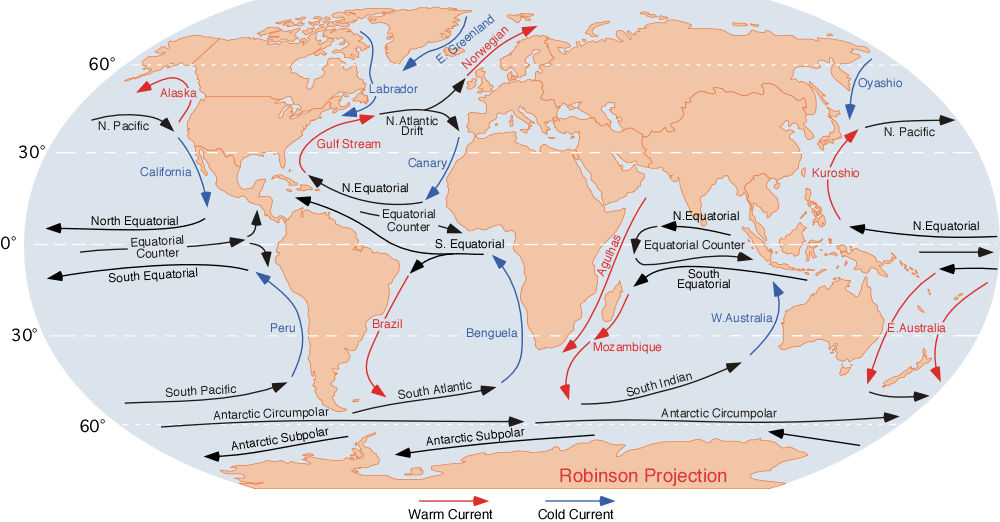The great Indonesian Throughflow
After finishing the 9am dive at Shark Point this morning, the main talk on the boat was about the ripping current. Some groups had more, some had less and some were just stuck in a machine of currents colliding.
So i thought it would be perfect to write about this peculiar movement of water. So lets start with the question: what is a current? Too put it simply, a current is a flow of moving water (usually forcing in the same direction). The reason for this is due to many different factors, for example: wind, waves, changes in temperate and salinity, and the Coriolis effect. Tides also have a big impact on how strong the currents are.
The Indonesian throughflow
Looking at the the great ocean map of how all the currents flow there is a pattern: in the northern hemisphere the currents are rotating clockwise, and in the southern hemisphere they rotate anti-clockwise. Due to the location of Indonesia, the currents the currents "should be" going from east to west. However, the usual current direction here (on the Gili islands at least) tend to run from north to south. How come? Indonesia's islands are basically a filter/passage between the great pacific and Indian ocean. The pacific sea level is 30cm higher than the Indian ocean, which creates a sub surface "waterfall", - or the Indonesian throughflow.
Looking at the "south equatorial current" the water should flow east to west, but reality gives us something different, with currents flowing north to south
There are four main passages in which the water flows, one of them being the Lombok Passage, which is the stretch of water between Bali and Lombok. Roughly 20% of the total amount of water passes there. So how much water is that? Well Norwegian scientist Harald Sverdrup realized that the amount of water flowing through was to big to be measured in gallons or liters, so he came up with the term "the Sverdrup" which is "one million cubic meters of water per second", and there is 20-22 Sverdrups flowing through. Unbelievable amounts of water!
So in the middle of these 22 Sverdrups lies the beautiful little island of Gili Trawangan. No wonder the divers of Dive Central Gili were amazed by the strength and speed of the current at Shark Point!
The face of different currents
The science on understanding how currents move and behave is easier said than done. If currents simply traveled right to left, diving in currents would be no problem, as they'd be nice and easy to predict. But currents can go many different directions, suddenly turning, changing, pushing up, pushing down, spinning like a washing machine, it can be quite unpredictable. So lets look at some different currents, how they occur and how to manage them.
Down currents
With a nasty reputation among divers, down currents occur when the flow of water hits the face on a drop off. They can also happen if two currents collide with each other, pulling the water downwards. The speed of the current can range from hardly noticeable, to a current that pulls down 15 meters in just a few seconds. Most down currents are weaker further away from the wall so try and kick out and, in a controlled manner, inflate your BCD to counteract the force. Just remember to deflate as soon as you escape the current to ensure that you don't ascend too quickly!
Up currents
As with a down current, an up current can occur if two currents collide or they face a wall or a drop off. The problem with an uncontrolled ascent (regardless of it happening due to expanding air or water pushing up) is an increased risk of Decompression sickness, lung over expansion injury or a gas embolism. So the best way to control your depth is to try and kick down against the current until you escape it, or you find a spot where it is not as strong. Try and also swim out away from the wall to find a point where the current is weaker.
Washing Machine
Exactly like the name tells us, this kind of current moves in a circular pattern, and can cause disorientation and quick changes in depth (up or down). This washing machine effect happens when the current bounces of the bottom topography uncontrollably. Best may to get out of one of these currents is to find a point where the current is pushing against you (the maintain depth) while kicking horizontally out from the area where the water is spinning around. The avoid disorientation - try and focus your eyes on one point, usually a part of the reef works well.
Vortex
A vortex current is quite rare. To give you an idea of what a vortex looks like, it can be the whirlpool in the wake of a boat or even smoke rings. A vortex current spins around an axis line. The best way to understand is by watching the video below, see how the puffer fish get caught up in the vortex! If you get caught in a vortex, try to stay calm, breath slowly until the current weakens and then quickly swim out from it perpendicular.
Diving in currents
Diving in current can sometimes be tricky. The more experience you have with currents the more you will enjoy it, as you will begin to learn how to spot them from the surface, how to check for them by doing a pre-dive current check, and how to deal with them if you get unexpectedly caught in one. Generally, the current is weakest closer to the reef ( with the exception of a down current!), so stay low (a great way to practice your buoyancy and keep your skills fresh!)
In some places where the current is always ripping, (like Komodo) most divers attach them self to a rock with a reef hook. This allows us to stay stationary without damaging the reef, it's just like watching a movie, you are safe and still and can watch the marine world pass you by without so much of a flick of a fin!
In the Gili islands, we always try to go with the current. This makes for much more relaxing diving and you get to see the whole dive site (sometimes even two sites in one dive!) Diving this way will also conserve your air, meaning that you will have a longer dive. and also conserve our air.
Diving in current is awesome, it just needs some time and practice!

